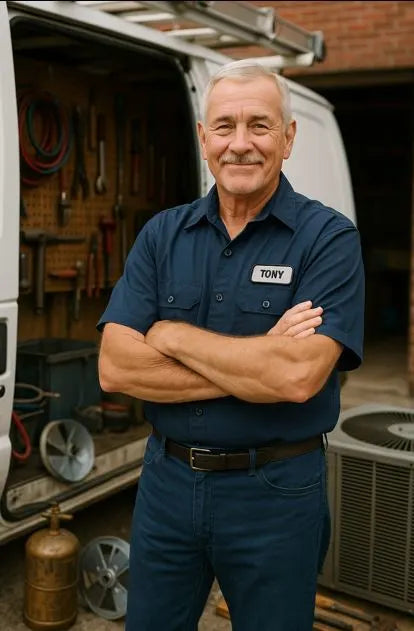How Efficient Is a 13.8 SEER2 Light Commercial System? Tony Breaks Down Real-World Power Bills & Cooling Performance
When business owners look at the Daikin Light Commercial 3-Ton Split System (DX3SEA3630 + AMST36CU1400) and see 13.8 SEER2, most of them ask Tony the same thing:
-
“Is 13.8 SEER2 efficient enough for my business?”
-
“Is SEER2 the same as SEER?”
-
“Will my power bill drop or rise?”
-
“Why isn’t this a 14, 15, or higher SEER product?”
Tony’s answer is simple:
“SEER2 is the new standard. A 13.8 SEER2 system cools better in real conditions than the old 14–16 SEER systems ever did on paper.”
This blog breaks down exactly how efficient this system is, how SEER2 actually affects costs, and how the Daikin Light Commercial unit performs under real commercial heat loads — not lab-controlled conditions.
1. SEER vs. SEER2: Tony’s “Simple Explanation” for Business Owners
Most people still think in SEER numbers.
But SEER2 replaced SEER in 2023 because SEER wasn’t accurate in real-world installations.
Tony breaks it down:
✔ SEER = lab test
✔ SEER2 = real-world ductwork test
SEER2 uses:
-
realistic airflow restrictions
-
realistic external static pressure
-
updated fan power calculations
-
updated coil performance conditions
So a 13.8 SEER2 Daikin actually cools closer to what an older 14–16 SEER unit delivered in real businesses.
[Light Commercial SEER2 Efficiency Testing]
2. What 13.8 SEER2 Really Means for Business Owners
Tony’s field-tested summary:
✔ Consistent cooling across long hours
✔ Stronger airflow than residential-grade systems
✔ Lower operating cost than older commercial units
✔ Better performance during high ambient heat
✔ Reduced strain under heavy daytime loads
A business needs cooling stability, not just efficiency numbers — and Daikin builds these units specifically for long-hour commercial usage.
3. Where 13.8 SEER2 Shines: Businesses With Predictable Cooling Needs
Tony installs these in:
-
small offices
-
retail shops
-
dental/medical suites
-
salon suites
-
classrooms
-
church admin spaces
-
storage rooms
These spaces have predictable internal heat loads and steady day-to-day cooling needs.
A 13.8 SEER2 system performs perfectly here without overcomplicating the system or inflating installation cost.
[Cooling Load Predictability Guide]
4. Energy Bills: What Business Owners Can Expect
Tony gives business owners this simple rule:
“A SEER2 system saves money by running efficiently under the pressure your building actually creates.”
Expected Savings When Upgrading to 13.8 SEER2
From an older 8–12 SEER commercial unit:
-
20–35% lower energy use
-
longer runtime comfort with lower peak draw
-
lower compressor stress
-
reduced blower wattage
Daikin’s commercial blower motor design is built for efficiency under long daily run hours.
5. Why 13.8 SEER2 Beats Higher-SEER Residential Systems in Commercial Settings
Tony gets this question a lot:
“Why not just install a 16 or 18 SEER residential unit?”
Because:
-
residential systems are not designed for commercial airflow
-
the blowers aren’t strong enough
-
coils aren’t optimized for commercial duct static
-
they can’t handle 10–12 hour daily runtime
-
warranty often invalid in commercial settings
This is why Daikin offers light-commercial 13.8 SEER2 systems — they’re engineered for commercial duty, not residential duty.
[Duty Cycle Performance Manual]
6. Commercial Static Pressure: The Real Efficiency Killer
Even the best SEER2 rating means nothing if your ducts are choking the system.
The Daikin 3-ton air handler needs:
✔ 1,200–1,350 CFM
✔ <0.50 in. w.c. total static pressure
If your ductwork is restrictive, SEER2 efficiency collapses.
High static pressure causes:
-
higher power draw
-
hotter discharge air
-
compressor strain
-
coil icing
-
blower noise
-
reduced cooling capacity
This is why Tony checks ductwork BEFORE sizing equipment.
[Light Commercial Static Pressure ]
7. Performance Under High Heat: Where Daikin Systems Stand Out
Light-commercial units often run during the hottest hours:
-
restaurants during lunch
-
retail during summer foot traffic
-
offices during full occupancy
-
classrooms during the afternoon
Tony sees this in the field:
✔ Daikin’s 13.8 SEER2 units maintain strong supply air temperatures even at 95–105°F outdoor temp.
This is where cheaper units fail — they lose cooling capacity under extreme heat.
Daikin maintains:
-
stable coil temperature
-
steady airflow
-
reliable head pressure control
-
strong compressor performance
8. Part-Load Efficiency: The Hidden Benefit Nobody Talks About
Businesses don’t always run at full load.
Tony explains it simply:
“Commercial systems spend 70% of their time running at part-load. That’s where SEER2 matters most.”
At part-load, Daikin systems perform:
-
cooler supply temps
-
steadier runtimes
-
lower compressor cycling
-
better humidity control
This improves comfort AND reduces bills.
9. Where Efficiency Drops — and How to Avoid It
Even a 13.8 SEER2 system can struggle if:
❌ ducts are undersized
❌ ceiling height is excessive
❌ internal heat load is too high
❌ return air is restricted
❌ the system is oversized or undersized
❌ the coil isn’t matched properly
❌ filters are neglected
Tony sees these issues constantly in older commercial buildings.
This is why proper installation is more important than the SEER2 number itself.
10. Tony’s Final Verdict: 13.8 SEER2 Is More Than Enough — If Installed Right
Tony’s summary:
✔ 13.8 SEER2 is a real-world commercial efficiency rating
✔ More stable than high-SEER residential systems
✔ Designed for long daily operating hours
✔ Performs strongly under heat and load
✔ Saves 20–35% vs older systems
✔ Provides consistent indoor comfort
✔ Depends heavily on proper ductwork & airflow
A Daikin 3-ton 13.8 SEER2 system is one of the most reliable and cost-effective commercial cooling solutions you can install — as long as it’s matched, ducted, and sized properly.
That’s Tony’s way.
Full step by step installation guide is provided in the next blog.







